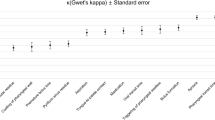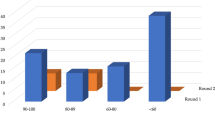Abstract
Objective
The videolaryngostroboscopy parameters form (VLSP form) is a diagnostic tool for the collection of videolaryngostroboscopic basic findings through the evaluation of 12 parameters. The aim of the present study is to preliminarily investigate intra- and inter-rater reliability, validity and responsiveness of the VLSP form.
Methods
A study on a total amount of 160 forms for the evaluation of VLS basic findings was carried out. 80 forms were scored through the VLSP form and 80 with the Voice Vibratory Assessment with Laryngeal Imaging (VALI) form Stroboscopy (S) by four expert phoniatricians, that blindly scored the VLS recordings of 5 subjects without voice disorders and 5 patients with organic voice disorder before and after successful phonosurgery. Intra-rater and inter-rater analysis have been performed for both forms. The scores obtained through VLSP form and VALI form S have been compared to analyse concurrent validity, while VLSP scores before and after phonosurgery have been compared to analyse responsiveness. Finally, each rater annotated the “difficulty” in rating every parameter and its “importance” for the diagnosis.
Results
The VLSP form showed good inter- and intra-rater reliability. It showed a good accuracy for the documentation of changes of laryngeal anatomy and function after phonosurgery, similarly to the VALI form S. The 12 parameters of the VLSP form were judged “Slightly Important” in 28.3% of the samples, “Very Important” in 64.8% of the samples, “Not Difficult” in 73.1% of the samples.
Conclusions
The results of the present study suggest that the VLSP form is comparable to the VALI form S for the evaluation of videolaryngostroboscopic parameters and is a valid, reliable and reproducible diagnostic tool. It can help voice clinicians in the evaluation of VLS examinations and it allows for a punctual assessment of modifications in laryngeal anatomy and function in pathological conditions and after phonosurgery.



Similar content being viewed by others
References
Hirano M, Bless D (1993) Videostroboscopic examination of the larynx. Singular Publishing Group, INC., San Diego
Cornut G, Bouchayer M (1986) Apport de la vidéostroboscopie dans les indications de phonochirurgie. Acta Otorhinolaryngol Belg 40:436–442
Crosetti E, Pilolli F, Succo G (2012) Nuove strategie di stadi azione endoscopica nel carcinoma laringeo: la multistep endoscopy. Acta Otorhinolaryngol Ital 32:175–181
Dejonckere PH, Bradley P, Clemente P, Cornut G, Crevier-Buchman L, Friedrich G, Van De Heyning P, Remacle M, Woisard V, Committee on Phoniatrics of the European Laryngological Society (ELS) (2001) A basic Protocol for functional assessment of voice pathology, especially for investigating the efficacy of (phonosurgical) treatments and evaluating new assessment techniques. Eur Arch Otorhinolaryngol 258:77–82
Lechien JR, Geneid A, Bohlender JE, Cantarella G, Avellaneda JC, Desuter G, Sjogren EV, Finck C, Hans S, Hess M, Oguz H, Remacle MJ, Schneider-Stickler B, Tedla M, Schindler A, Vilaseca I, Zabrodsky M, Dikkers FG, Crevier-Buchman L (2023) Consensus for voice quality assessment in clinical practice: guidelines of the European Laryngological Society and Union of the European Phoniatricians. Eur Arch Otorhinolaryngol. https://doi.org/10.1007/s00405-023-08211-6. (Epub ahead of print. PMID: 37707614)
Ricci-Maccarini A, Lucchini E (2002) La valutazione soggettiva e obiettiva della disfonia. Official lecture at the XXXVI National Congress of the Italian Society of Phoniatrics and Logopedics (SIFEL). Acta Phon Lat 26:13–42
Bless DM, Hirano M, Feder RJ (1987) Videostroboscopic evaluation of the larynx. Ear Nose Throat J 66(7):289–296
Ricci-Maccarini A, Bergamini G, Fustos R (2018) Proposal of a form for the collection of videolaryngostroboscopy basic findings. Eur Arch Otorhinolaryngol 275:1927–1933
Poburka Bj., RR. Patel, Bless DN (2017) Voice-vibratory assessment with laryngeal imaging (VALI) form: reliability of rating stroboscopy and high-speed videoendoscopy. J. Voice 31(4):523.e1–513.e14
Landis JR, Koch GG (1977) The measurement of observer agreement for categorical data. Biometrics 33(1):159–174 (PMID: 843571)
Poburka BJ (1999) A new stroboscopy rating form. J Voice 13:403–413
Bonilha HS, Desjardins M, Garand KL, Martin-Harris B (2018) Parameters and scales used to assess and report findings from stroboscopy: a systematic review. J Voice 32(6):734–755. https://doi.org/10.1016/j.jvoice.2017.09.018. (Epub 2017 Nov 2)
Acknowledgements
The Authors acknowledge Dr. Erennio Natale for his contribution in the preparation of the forms for the raters.
Author information
Authors and Affiliations
Corresponding author
Ethics declarations
Conflict of interest
The authors declare that there is no conflict of interest.
Ethical approval
All procedures performed in this retrospective study involving human participants were in accordance with the ethical standards of the institutional and/or national research committee and with the 1964 Helsinki declaration and its later amendments or comparable ethical standards.
Informed consent
Informed consent was obtained from all individual participants included in the study.
Additional information
Publisher's Note
Springer Nature remains neutral with regard to jurisdictional claims in published maps and institutional affiliations.
Presented at the PanEuropeanVoiceConference in Tallin on August 24th–27th, 2022.
Rights and permissions
Springer Nature or its licensor (e.g. a society or other partner) holds exclusive rights to this article under a publishing agreement with the author(s) or other rightsholder(s); author self-archiving of the accepted manuscript version of this article is solely governed by the terms of such publishing agreement and applicable law.
About this article
Cite this article
Ricci-Maccarini, A., Mozzanica, F., Fantini, M. et al. Validity, reliability and reproducibility of the VLS parameters form for the collection of videolaryngostroboscopic basic findings. Eur Arch Otorhinolaryngol 281, 2489–2497 (2024). https://doi.org/10.1007/s00405-024-08480-9
Received:
Accepted:
Published:
Issue Date:
DOI: https://doi.org/10.1007/s00405-024-08480-9




